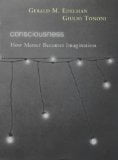 Consciousness: How Matter Becomes Imagination
Consciousness: How Matter Becomes Imagination
by Gerald Edelman and Giulio Tononi
Penguin, £20.00, ISBN 0713993081
If you have ever read (or tried) Edelman’s previous books you might expect this one to be equally incomprehensible.
It is not. Whether Edelman has learned how to explain his theories at last, or whether Tononi is entirely responsible, the result is a fascinating book with an entirely new take on the problems of consciousness.
Many theories of consciousness imply that certain groups of neurons or brain areas must be the conscious ones, without having any idea what this means. Others, as Dennett has so powerfully explained, assume an impossible “Cartesian Theatre” – a mythical time and place in the brain at which the results of unconscious processing suddenly “become conscious” or “enter consciousness” – again with no idea what this could mean. Edelman and Tononi refreshingly avoid these problems. They develop a selectionist theory of brain function known as Neural Darwinism or TNGS (the theory of neuronal group selection); with selection operating during development, during learning, and in what they call “re-entrant mapping”. They argue that although generating consciousness involves large populations of neurons in the thalamocortical system, consciousness is not a question of precisely which neurons are active, nor of how many, but of the kind of interactions between them.\They tackle what seems like a paradox – that consciousness seems, from the inside, to be both unitary and complex. That is, we cannot subdivide our own awareness, yet each conscious state is extraordinarily informative, being just one out of billions of possible states. Their solution is a mathematical theory resting on the concepts of mutual information and complexity. Consciousness depends on there being a dynamic core of neurons which is functionally integrated yet highly differentiated.
Among the many interesting ideas in the book are a non-representational theory of memory, the concept of the conscious scene as a “remembered present”, and the importance of looking at the problem from the point of view of the system itself. The theory is also testable – another reason why this book stands above the huge crowd of vacuous or mysterious theories of consciousness on offer today.



